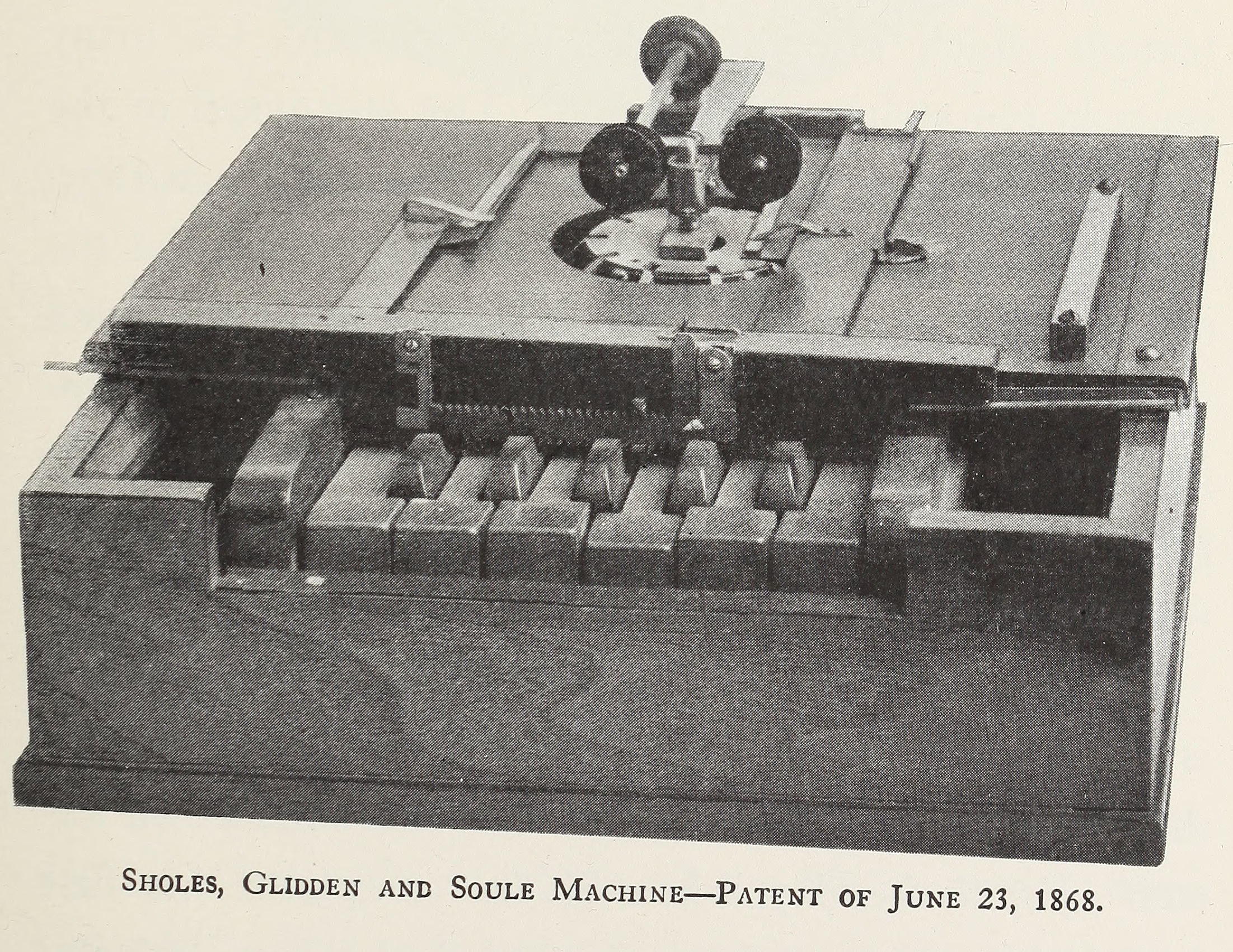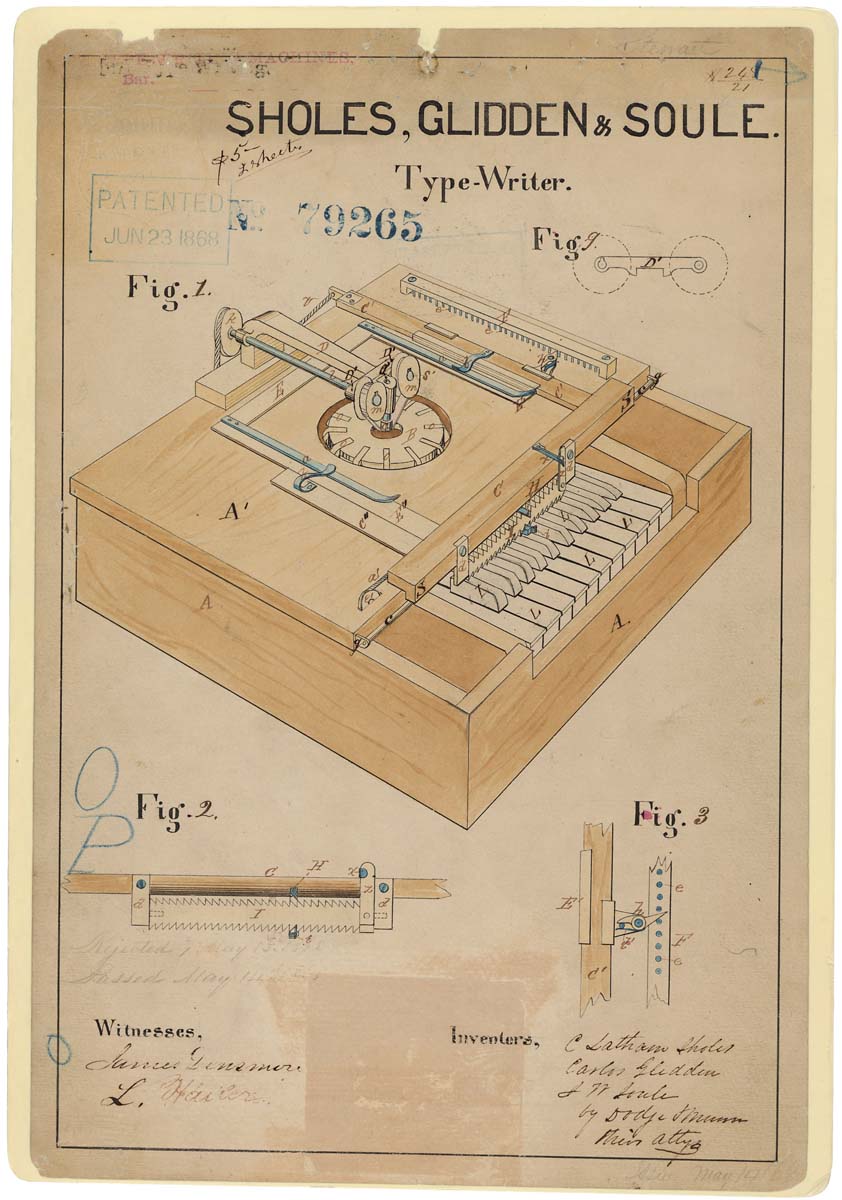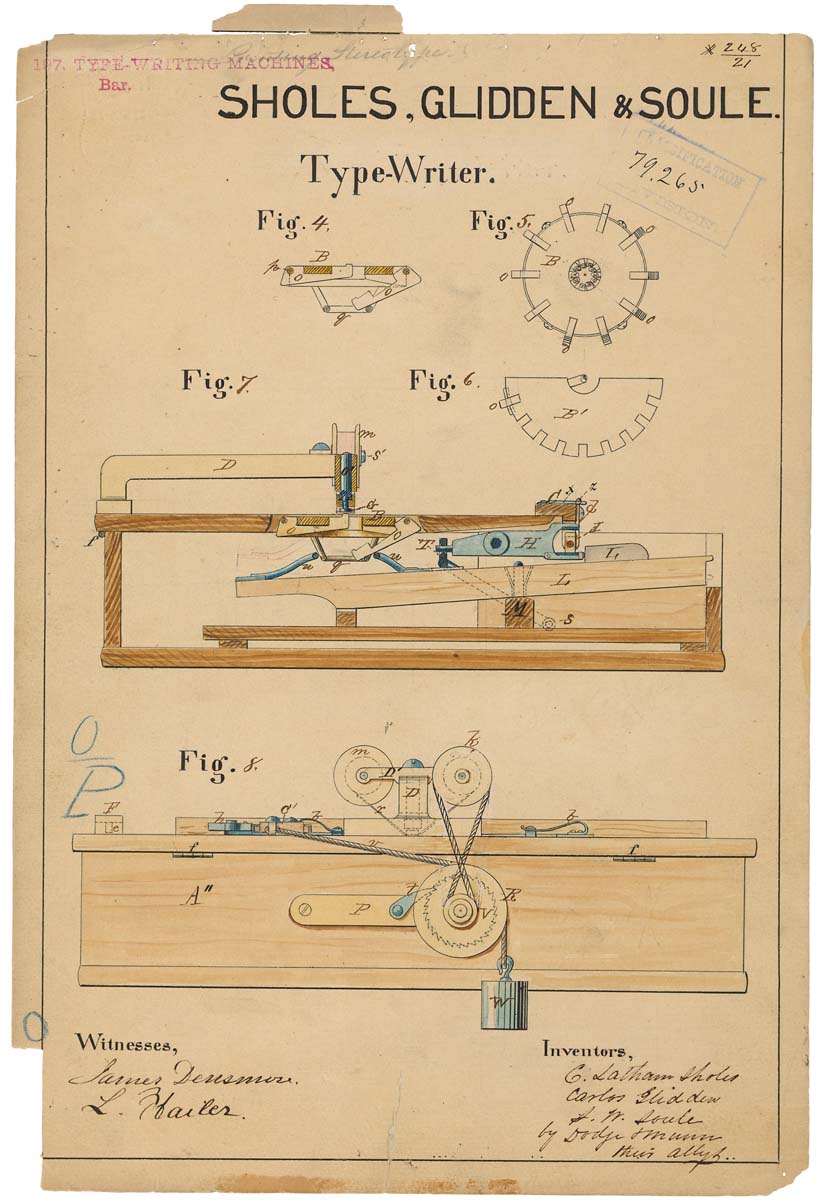【Zoe Voss Archives】
Life Before QWERTY
On Technology

The history of the typewriter is, as with the history of the personal computer after it, rife with collaboration, ingenuity, betrayal, setbacks, lucre, acrimony, misguided experimentation, and bickering white men. There are rough analogs for Bill Gates and for Steves Jobs and Wozniak (though there’s no one so delirious and insane as Steve Ballmer)—and one such analog is Christopher Latham Sholes, a Milwaukee printer whose first “type-writer” was patented 146 years ago today.
Sholes is widely credited with having invented the first QWERTYkeyboard. It helped to prevent jams and increase typing speeds by putting frequently combined letters farther apart—but that took years of trial and error; the initial iteration of his typewriter was far more rudimentary in design. It looks like a miniature piano crossed with a clock and/or a phonograph and/or a kitchen table—and Sholes did, in fact, design the prototype out of his kitchen table. As you can imagine, it didn’t boast what today’s designers would call “intuitive UX.” Its keys, borrowing from innovations in telegraphy, were arranged as such:
3 5 7 9 N O P Q R S T U V W X Y Z
2 4 6 8 . A B C D E F G H I J K L M
Notice the absence of 0 and 1; Sholes and his cohort assumed that people would make do with Iand O. They also couldn’t be bothered with lowercase letters—the first Sholes model was in a condition of eternal caps lock, doomed to permanent shouting. And yet in another sense Sholes was full of intuition and prescience: purportedly, the first letters he typed on the machine were “WWW.” George Iles’s 1912 book, Leading American Inventors, describes the mechanics:
The first row is of ivory, duly lettered; the second row is of ebony; and then, as you see, a third row, made up of letters and characters that are little used, is in the form of pegs. The framework is of wood, with the leverage below, and the basket form of typebars above closely resembles those of some machines in use today. The original model was very clumsy and weighty. The writing was on a tape of tissue paper, and the platen was fastened to the body of the boxlike affair. The writing could not be seen till it was completed, and when the document was once removed from the machine there was no way by which it could be replaced with any degree of certainty that the lines would correspond with those previously written.
 As an early developer declared, “It was good for nothing except to show that its underlying principles were sound.” But its technical advances, enumerated below, were enough to earn it a patent, and to attract the attention of investors and fellow inventors:
As an early developer declared, “It was good for nothing except to show that its underlying principles were sound.” But its technical advances, enumerated below, were enough to earn it a patent, and to attract the attention of investors and fellow inventors:
(1) A circular annular disc, with radial grooves and slots to receive and guide the typebars so that they struck the center. (2) Radial typebars to correspond with this disc. (3) A ratchet to move the paper-carriage by the breadth of a tooth when a key was struck. (4) A hinged clamp to hold the paper firmly on its carriage.
Sholes was intent on winning over the stenographer demographic—he assumed such workers were the likeliest customers, and that they would do the most to improve the product—so he did the natural entrepreneurial thing and hired a consultant. He sent James Ogilvie Clephane, a renowned court reporter in Washington, D.C., an early model and told him to give it hell. Clephane did; so unforgiving was his field-testing that he destroyed a succession of costly prototypes, and he told Sholes in no uncertain terms that his typewriter was garbage. But his brutal feedback began the long process that culminated in the QWERTYdesign.
Not that this was a cakewalk; Sholes and his companions went through years of prototypes, and fell deeply into debt, before they arrived at a marketable model, and even then, in 1874, no one really wanted the typewriter, known by that point as the Remington 1. It cost $125, a small fortune for the day, and typewritten correspondence was stigmatized as impersonal and impolite. Sholes faced competition from a league of rival manufacturers, many of whom he’d once worked with.
 Still, in its incipient form, Sholes’s machine was at least fun to develop. Leading American Inventorsincludes this bucolic account of work in the Milwaukee mill where he held court with his colleagues, Carlos Glidden and Samuel Soule:
Still, in its incipient form, Sholes’s machine was at least fun to develop. Leading American Inventorsincludes this bucolic account of work in the Milwaukee mill where he held court with his colleagues, Carlos Glidden and Samuel Soule:
In that grimy old mill on the Rock River Canal there were interludes to lighten and brighten the toil of experiment. All three partners were chess players of more than common skill, and they often turned from ratchets and pinions to moves with knights and pawns. Ever and anon a friend would drop in, and the talk would drift from writing by machinery to Reconstruction in South Carolina, or to the quiet absorption by farms and mills of the brigades mustered out after Appomattox. Then, with zest renewed, the model was taken up once more, to be carried another stage toward completion. One morning it printed in capitals line after line both legibly and rapidly. Sholes, Soule, and Glidden were frankly delighted.
Today the site is marked with a reverent plaque, courtesy of the Milwaukee County Historical Society, which buoyantly claims that “C. Latham Sholes perfected the first practical typewriter.” Would that it were so.
Search
Categories
Latest Posts
Giuliani’s Pooch
2025-06-25 21:43Hackers steal $32 million worth of crypto from Bitpoint
2025-06-25 21:43Sprawling storm Barry intensifies into a hurricane
2025-06-25 21:06Retirement, Brought to You by Prisons, Inc.
2025-06-25 20:24Popular Posts
Emboldened Fight for Health Care as a Right
2025-06-25 22:13Juul CEO super 'sorry' he got your teens addicted to fat clouds
2025-06-25 21:57What kind of Snapchatter are you?
2025-06-25 21:16The Arctic burns with unprecedented fires
2025-06-25 21:15Old-School Organizing in the Heartland
2025-06-25 20:54Featured Posts
Dr. Zuckerstein’s Monster
2025-06-25 22:39Did Kim Kardashian hint at a divorce before her long
2025-06-25 22:36Facebook Libra slammed by Congress in hearing
2025-06-25 21:27The Commons are Rumbling
2025-06-25 20:27Popular Articles
Fire and Fury
2025-06-25 22:22First messages to send on Tinder if you want to be forever alone
2025-06-25 22:14Report: Amazon's pouring more resources into Alexa
2025-06-25 22:11Mathematical study shows exactly how ride
2025-06-25 22:05Friends in Stupid Places
2025-06-25 21:21Newsletter
Subscribe to our newsletter for the latest updates.
Comments (435)
Creation Information Network
Boys to Men
2025-06-25 21:47Style Information Network
Why absolutely everyone should be concerned about facial recognition
2025-06-25 21:24Habit Information Network
Prince Harry and Meghan Markle officially meet Beyoncé and Jay
2025-06-25 20:30Co-creation Information Network
Trump's brief Twitter follow reveals possible love for adorable kittens
2025-06-25 20:27Happiness Information Network
How to Lie: Donald Trump, Jr. fails in the family trade
2025-06-25 20:21